




Optimux-134 ( OP-134 ) Fiber Optic Multiplexer for 16-Channel E1 TDM and Ethernet
RAD Optimux-134 ( OP-134 ) Fiber Optic Multiplexer for 16-Channel E1 TDM and
Ethernet highlights:
• Up to 16 E1 links, full bandwidth 100 Mbps Ethernet traffic and high-speed data multiplexed into fiber optic uplink
• 34 Mbps or 134 Mbps operation modes
• Single-mode, multimode, single-mode over single fiber, SFP-based interfaces
• Range of up to 110 km (68 miles)
• Optional additional hot-swappable power supply and uplink for redundancy
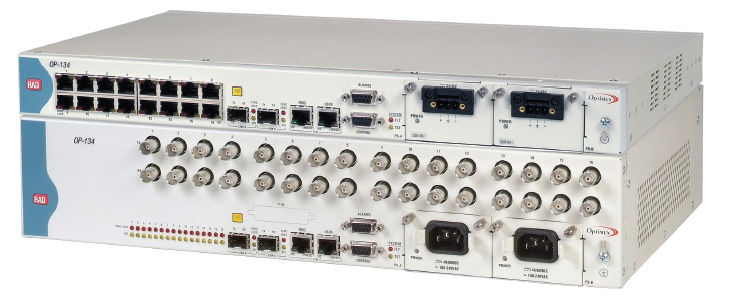
Optimux-134 provides a simple, flexible, and cost-effective solution for transporting multiple E1 links, high-speed data and Ethernet over an E3 copper or fiber link, to distances of up
to 110 km (68 miles).
The RAD Optimux-134 ( OP-134 ) product features two license-activated operation modes:
•
In 34-Mbps operation mode, the units are fully compatible with Optimux-34
•
In 134-Mbps mode, the products feature transport at 100 Mbps user Ethernet traffic.
The fiber optic link is available with single-mode, multimode, and single-mode over single fiber interfaces.
In 34-Mbps device operation mode, the Optimux-134 uplink is compliant with E3 standards for coax interfaces and works with 3rd party devices. The Optimux-134 uplink with fiber
interfaces is proprietary in both device operation modes.
In 34 Mbps operation mode, the unit multiplexes up to 16 E1 links. The data rate of the TDM ports can partially be replaced (user-selectable) by the 10/100BaseT user Ethernet traffic
or by an optional high-speed data V.35 interface (see Table 1).
Optimux-134 ( OP-134 ) Uplink Interfaces
Various interfaces (based on SFP transceivers) are available for both the active and the backup uplinks (see Table 2 and Ordering Options):
•
Electrical via coax (SMB) connector (34 Mbps mode operation only)
•
1310 nm short or long-haul laser and 1550 nm long-haul laser interfaces for extended range over single-mode fiber
•
Single fiber interface using WDM technology, with the laser transmit signal at a different wavelength than the receive signal (1310 nm and 1550 nm).
Optional Link Redundancy is available with Optimux-134 ( OP-134 )
Upon link failure, the unit automatically switches to an optional second uplink as a backup.
E1 Interface of Optimux-134 ( OP-134 )
Optimux-134 multiplexes 16 E1 channels. The E1 interfaces comply with the ITU-T G.703. Line coding is HDB3 or B8ZS, respectively. A pair of LEDs monitors loss-of-signal and AIS
on each E1 receive line.
RAD Optimux-134 Fast Ethernet Interface
Optimux-134 features fast Ethernet ports enabling a full 100-Mbps Ethernet connection in addition to the capacity of the 16
E1 channels. The OP-134 devices are supplied with a 10/100BaseT Ethernet USER port. This port is activated via a software key. The license can be purchased for
8 Mbps granularity to work in 34 Mbps operation mode, or for full bandwidth to work in 134 Mbps operation mode.
OP-134 V.35 Interface
The Optimux-134 devices can be supplied with one V.35 (2048 kbps) channel that replaces channel 16 by user activation. The V.35 interface can
only be used in 34 Mbps operation mode.
Optimux-134 ( OP-134 ) timing
The Optimux-134 ( OP-134 ) devices transmit each E1 channel separately so that the clock of each E1 channel is independent. The
OP-134 supports internal and loopback timing modes. The 134 Mbps operation mode uses only Internal timing.
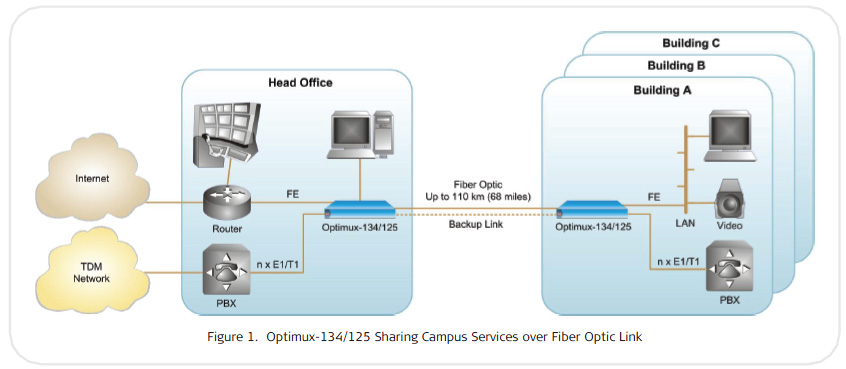
Typical Optimux-134 ( OP-134 ) applications include:
Private Networks
In private networks, Optimux-134 shares campus services such as Ethernet, Voice, Data and Video in P2P (Figure 1) and Star topologies over dark fiber.
Optimux establishes TDM and Ethernet connectivity between the remote branches and headquarters for educational, financial, military sectors.
Traffic Backhaul Application
Optimux-134 transparently backhaul TDM & ETH traffic over fiber or coax uplink (see Figure 3).
Optimux devices connect cellular base stations to controllers. This solution meets the requirements of cellular backhaul applications by providing TDM and Ethernet traffic for CDMA
and GSM connectivity.
The Optimux units backhaul WiMAX traffic from remote locations over dark fiber links at a distance of up to 110 km (68.3 miles).
Diagnostic features of OP-134
Optimux-134 features comprehensive test and diagnostic capabilities that include local and remote loopbacks on the uplink interface and on each E1 port. A local loopback is also supported on the optional V.35 user port.
To ease system diagnostics, Optimux features LED status indicators and AIS alarm generation and recognition.
The Optimux-134 ( OP-134 ) also feature dry contact closure upon link failure. An optional alarm port is available with dry relay contacts for major and minor alarms.
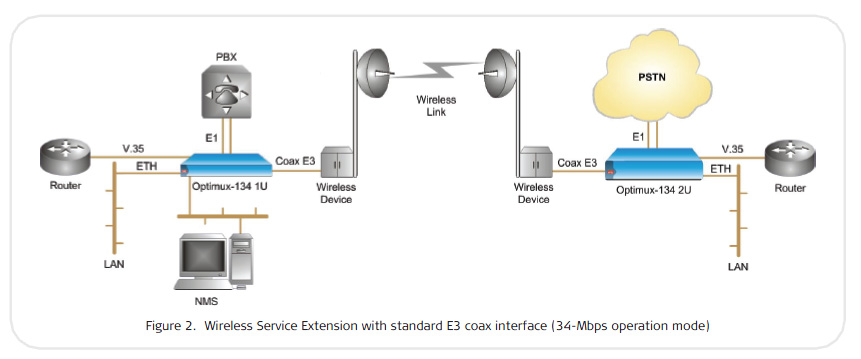
Management of Optimux-134
The Optimux -134 units can be configured and monitored with a number of management and diagnostic tools. An ASCII terminal and Telnet provide local management. Remote
management and diagnostics can be performed via a RAD Web-based management application or an SNMP-based management application. The products working in 34 Mbps
operation mode can be managed RADview, RAD's SNMP-based management application.
Physical information
Optimux-134 is available in a 1U-high version with balanced E1 interface, and RJ-45 connectors, or a 2U-high version with unbalanced E1 interface, and BNC or IEC-169/13
connectors. All the units can be mounted in a 19-inch rack.
Power
The wide-range AC/DC power supply can be connected to either an AC power source (90 to 260 VAC), or a DC power source (–40 to -72 VDC). The units may also be ordered with
a +24 VDC (20 to 72 VDC) power supply. A second power supply can be ordered for power redundancy.
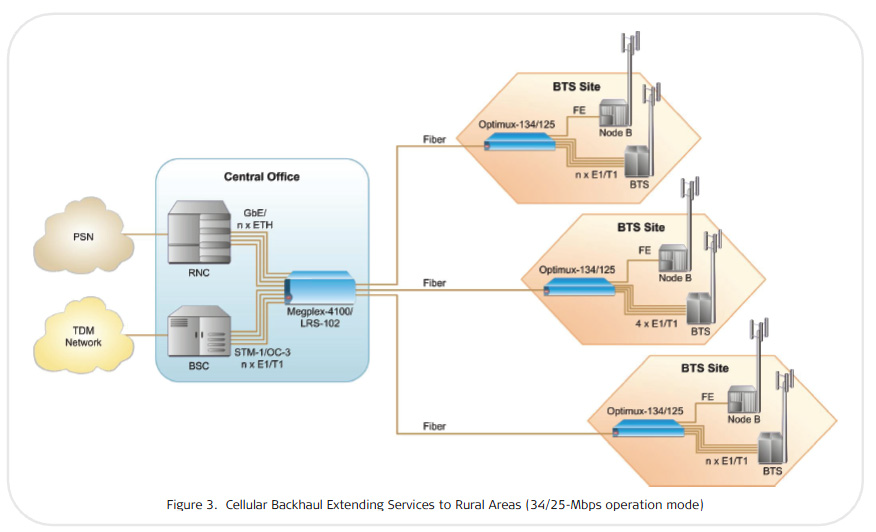
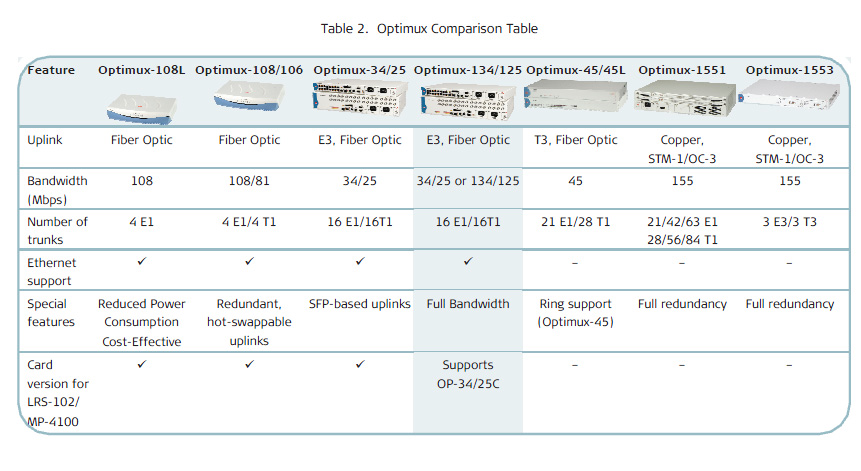
Optimux-134 ( OP-134 ) Product data sheet (pdf)